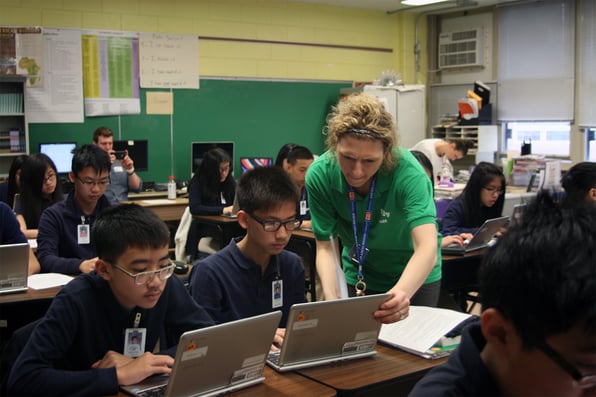
Stories from the Classroom: Observations from Healy Elementary School
This week, Team ThinkCERCA got the opportunity to drop into Katie Zwierzynski's 8th grade social studies class at Robert Healy Elementary School in Chicago. Katie has been teaching for nearly 12 years and using ThinkCERCA for three. Here, we outline three takeaways from our visit to help you implement ThinkCERCA in your classroom.
Technology Access
1:1
Classroom Layout
Students were grouped in pairs for easy collaboration.
Additional Notes
Although each student had their own device, Katie projected the lesson as well to model expectations and ensure that every student was taking full advantage of the critical thinking process.
Takeaway #1: Literacy Works Best Across Disciplines
ThinkCERCA works best when used as a cross-curricular literacy tool, which is why we designed our lesson library with thematic and topical connections to make this best practice easier for all of our teachers. During our observation, Katie walked through steps 1-6 of our “Poetry: Bivouac on a Mountain Side” lesson, which explores the harsh reality of the Civil War through Walt Whitman’s poetry. In this scenario, Katie and an English language arts colleague selected the poem together because of its thematic ties to a novel the students just read, The Red Badge of Courage. Throughout class, she encouraged students to make connections between the Applied Lesson and the novel to deepen their understanding of the Civil War.
Takeaway #2: Collaboration is Key
Research shows us that peer-to-peer discussion and debate are key to improved student outcomes. Katie encouraged collaboration by asking her students to either turn and talk with their partner or share their thoughts aloud to the entire group after every step of the Applied Lesson. She even asked students to debate multiple choice items with the entire class to deepen their understanding of why the right answer was right and the wrong answer was wrong.
Takeaway #3: Common Practices Pair Nicely with ThinkCERCA
Katie implemented a common best practice, prediction strategy, to help students check their comprehension and confirm understanding of vocabulary words. After reviewing the list of vocabulary words highlighted in the ThinkCERCA lesson, students were asked to use context clues from the topic overview to develop their own definitions and how these words apply to the concept of war.

Elizabeth Riley Boyer is an experienced journalist, digital content strategist, and operations manager. Prior to joining ThinkCERCA, she was part of the founding team at Impact Engine, Chicago’s first social impact investment fund and accelerator. As Impact Engine’s Director of Operations & Communications, Elizabeth oversaw the company’s overall processes, day-to-day planning and finances, curriculum development, marketing strategy, and community outreach.
Elizabeth also spent three years at Chicago magazine, most recently as its Digital Engagement Editor, where she managed the organization’s social media and reader engagement initiatives. Elizabeth also works as a freelance content strategist, writer, and communications consultant. Her recent writings on impact entrepreneurship have been featured by the Huffington Post and Crain’s Chicago Business.
In 2007, Elizabeth helped open a private school for underprivileged children while volunteering for a nonprofit organization in the Dominican Republic. This experience inspired her to quit a paper-pushing job at an insurance brokerage firm to pursue a master’s degree in journalism from Northwestern University. Elizabeth also holds a bachelor’s degree in American studies from the University of Texas at Austin.
